Cicadas and locusts are different types of insects, though they share many similarities. Both have distinctive songs, aimed at attracting females, and can fly. However, cicadas are true bugs that eat sap, whereas grasshoppers are Orthoptera and eat plant matter.
Contents
Similar but not the same
It is often easy to mistake different kinds of animals for each other because of similarities in their behaviour or looks. Sometimes these misidentifications can be down to the fact that two species are closely related and so share many similar features, such as with big cats like jaguar and cheetah. Sometimes, however, the mistake is because the animals have evolved to deal with similar problems. An example of this would be flight in birds and insects, which evolved separately to overcome a similar constraint.

Cicadas and locusts are different types of animal that are often confused for one another. In part, this is because they are related, though distantly. Both are part of the Insecta class, being insects. However, locusts fall within the Orthoptera order, which includes grasshoppers and crickets, while cicadas are in the Hemiptera, or true bug order, along with aphids and leafhoppers.
Both being insects means they have many common features, such as six legs, a pair of antennae and an exoskeleton, as well as a body made of three parts; the head, the thorax and the abdomen. Like many insects, they also have wings and compound eyes. They are both also often green or brown, though some more brightly coloured species exist. This is to help camouflage them from the many predators wanting to take a bite.
| Characteristic | Cicadas | Locusts |
|---|---|---|
| Body Shape | Stout body with a wide head and short antennae | Slender body with a narrow head and long antennae |
| Wing Structure | Transparent wings with intricate veining | Long, narrow wings that cover most of the abdomen |
| Color | Typically brown or green, often with vibrant markings | Usually brown or gray, often with less distinct markings |
| Size | Vary in size from 1 to 2 inches (2.5 to 5 cm) in length | Vary in size from 0.5 to 2 inches (1.3 to 5 cm) in length |
Yet, despite all these similarities, there’s still a great deal that sets these two groups apart. So what makes a cicada a cicada and a locust a locust?
What is a locust?
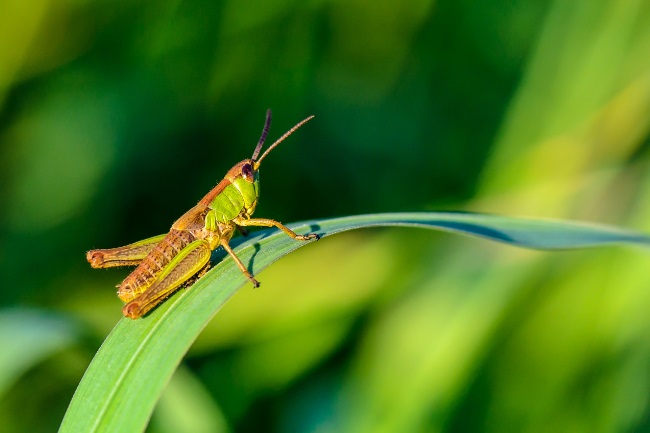
Locusts are a type of grasshopper that transforms from a solitary creature to one that swarms during certain conditions. Though not all locusts have a significant impact on human livelihoods, there are several species that have become famous for their intermittent plagues, such as the desert locust.
Like all grasshoppers, locusts have long back legs, which are powerful enough to propel them quickly through the air when they want to escape. They also have two sets of wings, which are normal folded away on their body to prevent damage. When a locust transforms from its solitary to its gregarious form, its wings lengthen and become stronger, as it will often travel great distances in search of food.
| Characteristic | Cicadas | Locusts |
|---|---|---|
| Lifecycle | Spend most of their lives underground as nymphs | Undergo incomplete metamorphosis with nymph and adult stages |
| Sound Production | Produce loud buzzing or clicking sounds to attract mates | Produce buzzing or rattling sounds during swarming behavior |
| Feeding Habits | Feed on plant sap as nymphs and adults | Feed on a wide range of plant material including crops |
| Swarm Behavior | Not known for swarming behavior | Display swarming behavior in response to environmental cues |
What causes this transformation is primarily climate, with heavy rains causing a flush of vegetation that rapidly increases locust numbers. When a drought then follows this bounty, the vegetation shrinks back to a few places. The density of locusts then builds as they are forced into smaller and smaller areas until a critical mass causes their serotonin levels to rise and they physically begin to change. As well as their wings lengthening, they also change colour.
In their solitary form, locusts eat primarily grasses, just like other grasshoppers, with some species branching out to different types of vegetation. Once they have transformed, they will also take advantage of accessible sources of meat, such as other insects and roadkill. They are also more than happy to eat each other if given a chance, and scientists think this is why the swarm keeps advancing, with the front locusts driven on by their ravenous relatives behind.
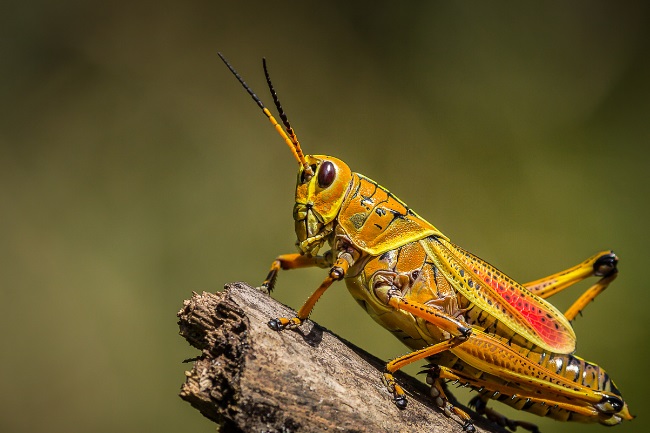
Like grasshoppers, locusts can sing. Grasshoppers usually sing either by rubbing their back legs across their wing casings or by snapping their wings taut as they fly. Their back legs are covered in small nodules, which cause the wing casings to vibrate. Different species have different sized and shaped nodules, creating different sounds. These sounds are used to attract females, who can distinguish which males are larger and healthier from the sounds they make. Most species sing in the daytime, particularly in the evening.
Locusts start life as an egg. Eggs are laid in large batches and covered in a protective casing. Most species lay their eggs in the soil, though some will lay them into vegetation. The eggs hatch into nymphs that are miniature versions of the adults. These grow throughout the summer, becoming fully mature and mating. Most grasshoppers live roughly a year, with adults not surviving the winter, and the eggs laid in the summer hatching the following spring.
What is a cicada?
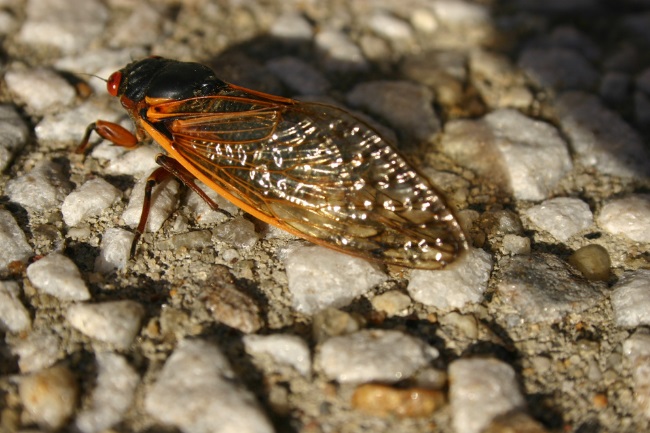
Cicadas are found on all continents aside from Antarctica. There are over 3,000 different species with the highest diversity found in New Zealand and Australia, and South America. Like all insects, they have three main body parts, the head, the thorax and the abdomen. However, unlike locusts, these body parts are not as well defined or easy to separate for the untrained eye, the whole body seeming to be one connected mass.
| Characteristic | Cicadas | Locusts |
|---|---|---|
| Ecological Role | Play a role in nutrient cycling and forest ecosystem dynamics | Can be significant agricultural pests, causing crop damage |
| Economic Impact | Limited economic impact | Can lead to crop losses and food insecurity in affected regions |
The prominent features are the large eyes on the head and the two pairs of wings that cover most of the body. Unlike locusts, these wings aren’t folded and hidden away against the body but are kept on display, positioned on either side of the thorax and pointing down the body, often extending beyond the end of the abdomen.
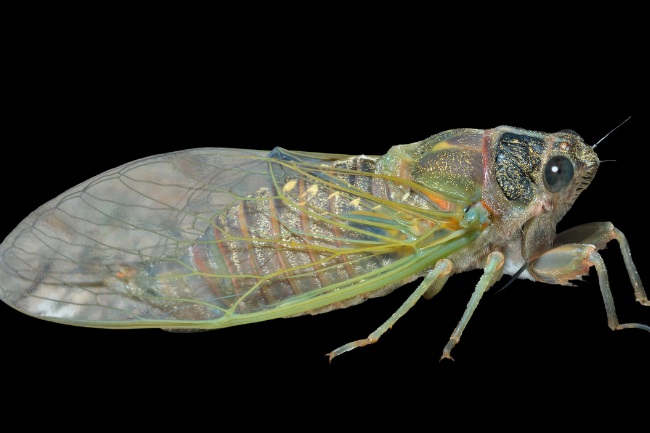
Like locusts and grasshoppers, cicadas are famed for their song. As with many other insects, this song is created by the male in order to attract a female. Though some cicadas practice stridulation like grasshoppers, where the wings are rubbed against another body part to create sound, in this case, the thorax, most produce noise using their abdomen.
This involves the rapid movement of a pair of structures known as tymbals. By flexing their muscles rapidly, these structures create the song of the cicada. Some species also have hollow areas in their abdomens to amplify the sound.
Cicadas start their life as an egg, which is laid in cuts made in vegetation by the females. Once the egg has hatched, the nymphs fall to the ground and burrow into the soil. How long they live within the soil varies hugely from species to species, between one year and seventeen. Once ready, they emerge from the ground and moult to become an adult.
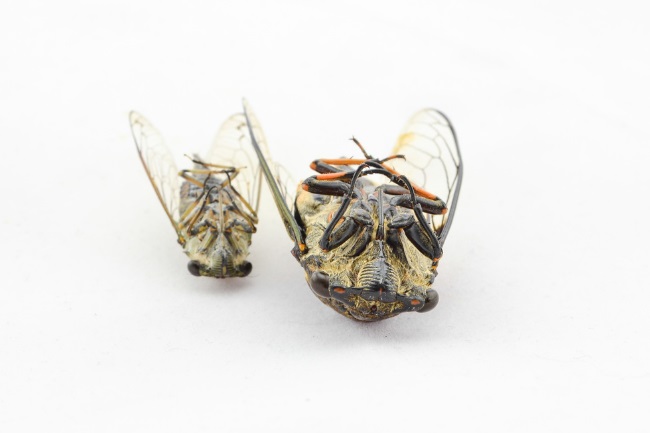
Both adult and juvenile cicadas eat plant sap. It is their probing mouth parts that sit them within the true bug group. Like other sap-sucking members of the group, such as aphids, they excrete a sweet liquid known as honeydew, helping them to get rid of excess sugars and liquids.
Unlike locusts, cicadas are terrible jumpers. Froghoppers, who also sit in the true bug group, have a very similar body shape to that of cicadas, however, they are much smaller in size. These tiny insects are even better hoppers than grasshoppers, and this can lead some people to think that they and the similar-looking cicadas are related to grasshoppers. Instead of hopping, cicadas largely get around by flying.
Some people confuse locusts and cicadas because certain species of cicadas appear in large numbers on some years. Some species have 15 or 17-year emergencies, so as to overwhelm predators when they emerge. Like locusts, cicadas can cause damage to commercial crops, through these would primarily be tree species. By sucking sap, they can weaken the trees or introduce disease, and honeydew can encourage the growth of some moulds. However, they are nowhere near as damaging as swarms of locusts are on arable crops.
The good, the bad, the ugly
Cicadas and locusts are different types of insects; however, they do share many similarities from their fascinating songs to their arrival in large numbers and their importance in the folklore of many different countries. Both can cause problems when their numbers rise suddenly. However they are also an important food source for many other species around the world.
Though they may sometimes be seen as pests, could we really imagine walking through a meadow without the sound of the grasshoppers and locusts? Or wandering through a rainforest without the song of the cicadas? Perhaps not.

